Financial Management & Control: Zurich Plc and Johnson Ltd Analysis
VerifiedAdded on 2020/06/04
|14
|4342
|57
Report
AI Summary
This report provides a comprehensive financial analysis of two companies, Zurich Plc and Johnson Ltd. Part A focuses on Zurich Plc, calculating and interpreting relevant financial ratios across profitability, liquidity, gearing, capital employed, and asset utilization. It evaluates the limitations of ratio analysis, considering factors like inflation and accounting variations. Part B shifts to Johnson Ltd, employing investment appraisal techniques to assess the feasibility of acquiring a machine. The report critically evaluates the benefits and limitations of these techniques and identifies optimal financing sources. The analysis includes detailed calculations, comparative data, and critical evaluations to provide a thorough understanding of the companies' financial positions and management strategies. The report concludes with recommendations based on the findings and references supporting literature.
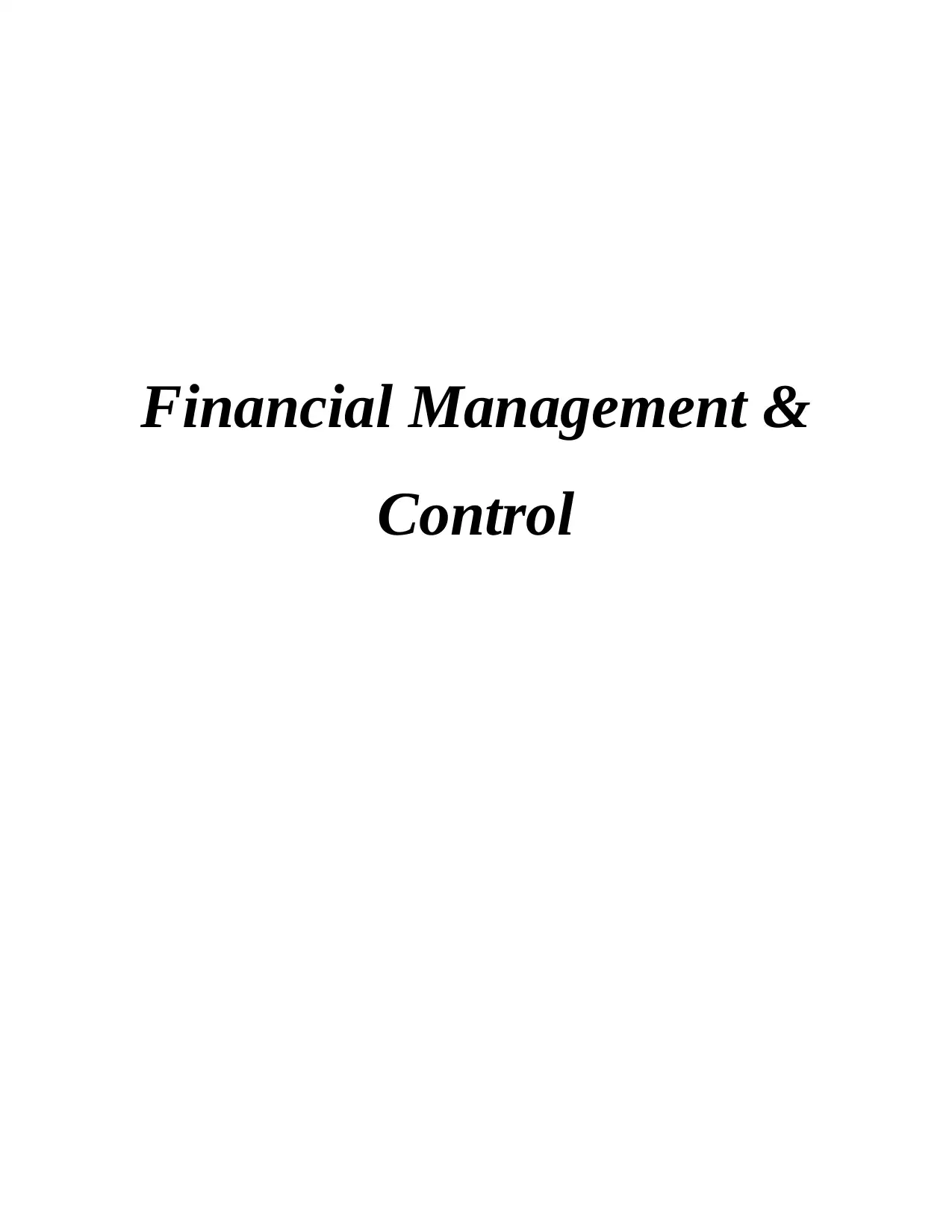
Financial Management &
Control
Control
Paraphrase This Document
Need a fresh take? Get an instant paraphrase of this document with our AI Paraphraser

Table of Contents
INTRODUCTION...........................................................................................................................1
PART A- Zurich Plc .......................................................................................................................1
1: Calculation of relevant ratio....................................................................................................1
2: Critical evaluation of limitation of ratio analysis....................................................................4
PART B – Johnson Ltd....................................................................................................................6
1. Calculation by using investment appraisal techniques............................................................6
2: Critical evaluation of key benefits and limitation of every investment tools.........................8
3: Critical evaluation of best possible sources of finance........................................................10
CONCLUSION..............................................................................................................................11
REFERENCES..............................................................................................................................12
INTRODUCTION...........................................................................................................................1
PART A- Zurich Plc .......................................................................................................................1
1: Calculation of relevant ratio....................................................................................................1
2: Critical evaluation of limitation of ratio analysis....................................................................4
PART B – Johnson Ltd....................................................................................................................6
1. Calculation by using investment appraisal techniques............................................................6
2: Critical evaluation of key benefits and limitation of every investment tools.........................8
3: Critical evaluation of best possible sources of finance........................................................10
CONCLUSION..............................................................................................................................11
REFERENCES..............................................................................................................................12

INTRODUCTION
Finance is said to be important aspect for every business organisation. It is a
comprehensive system of internal controls that is put in accordance with formulating new
business plan. The responsibility of budget users heads by way of control risks that are arises in
an organisation. Management is always trying to make valuable planned activities that aims to
attain desired return on the total investment. Managers can use financial statement, operating
ratios and other crucial aspects those are related with exercise financial control.
This project report is providing vital information about two major companies such as
Zurich Plc and Johnson Ltd. Calculation of relevant ratios in five analytical areas. On the basis of
computed ratios, certain limitation is being done to make decision more effective. Evaluation of
investment appraisal techniques and make specific recommendation to determine feasibility for
acquiring the machine. Benefits and limitation of every techniques are evaluated in more
effective manner under this report (Brigham and Houston, 2012).
PART A- Zurich Plc
1: Calculation of relevant ratio
According to this particular company which is a public limited company deal in
production and distribution of office equipment. The owner after making analysis has found that
there are something which is lack which is making impacts on profitability and liquidity position.
To remove those issues, they has appointed a new financial analyst to review and analyse
performance of the company by taking last two year data.
Profitability ratio: It is known as financial measured that is use to assess a business
ability to incur incomes compare to their expenses and other costs those are incur during the
time. It evaluate their ability to generate profit in accordance with the total earning, balance
sheet, operating costs and shareholder equity. This seem to be an effective ratios which is used to
determine companies ability to generate profit for the company. Profit margin use to assess
ability to turn incomes into profit. Return on assets help to measure “Zurich Plc” to analyse their
net income produce during the time (Higgins, 2012). There are various types of profitability
ratios those are discussed underneath:
1
Finance is said to be important aspect for every business organisation. It is a
comprehensive system of internal controls that is put in accordance with formulating new
business plan. The responsibility of budget users heads by way of control risks that are arises in
an organisation. Management is always trying to make valuable planned activities that aims to
attain desired return on the total investment. Managers can use financial statement, operating
ratios and other crucial aspects those are related with exercise financial control.
This project report is providing vital information about two major companies such as
Zurich Plc and Johnson Ltd. Calculation of relevant ratios in five analytical areas. On the basis of
computed ratios, certain limitation is being done to make decision more effective. Evaluation of
investment appraisal techniques and make specific recommendation to determine feasibility for
acquiring the machine. Benefits and limitation of every techniques are evaluated in more
effective manner under this report (Brigham and Houston, 2012).
PART A- Zurich Plc
1: Calculation of relevant ratio
According to this particular company which is a public limited company deal in
production and distribution of office equipment. The owner after making analysis has found that
there are something which is lack which is making impacts on profitability and liquidity position.
To remove those issues, they has appointed a new financial analyst to review and analyse
performance of the company by taking last two year data.
Profitability ratio: It is known as financial measured that is use to assess a business
ability to incur incomes compare to their expenses and other costs those are incur during the
time. It evaluate their ability to generate profit in accordance with the total earning, balance
sheet, operating costs and shareholder equity. This seem to be an effective ratios which is used to
determine companies ability to generate profit for the company. Profit margin use to assess
ability to turn incomes into profit. Return on assets help to measure “Zurich Plc” to analyse their
net income produce during the time (Higgins, 2012). There are various types of profitability
ratios those are discussed underneath:
1
⊘ This is a preview!⊘
Do you want full access?
Subscribe today to unlock all pages.

Trusted by 1+ million students worldwide

Gross profit margin: According to this particular ratio which is used to measure
profitability of product and services a company sells to their customers. It provide information
about total cost a company need to make the product.
Gross profit margin: Gross profit / Net sales *100
2015 : 7382/18920 *100= 39.01 %
2016 : 5825/16243 *100=35.86%
Operating profit margin: This would take into account total cost of producing the
product and services that are not associated to direct production process. Such as overhead and
administrative expenditure.
Operating margin: Operating profit / Net sales *100
2015: 2582/18920*100=13.64%
2016: 1783/16243*100=10.97%
Return on assets: It is used to measure about how effectively Zurich Plc produces
income from its assets (Chandra, 2011). This would dividing net income for present time through
the value of all assets that a company keep with them.
ROA: EBIT /Assets *100
2015: 2582/6503 *100=39.70%
2016: 1783/ 7006 *100= 25.44%
Return on equity: According to this particular ratio, finance manager use to measure
vital information about company that process of making each pound that investors put into it. It
is a corporations gains by revealing about total profit a company incur with total money investors
has invested in their projects.
ROE: Net income / Shareholder equity *100
2015: 2582/ 20108 *100= 12.84%
2016: 1783/ 19635 *100=9.08%
Liquidity ratio: It is use to analyse the ability of a company to make payment off both
current liabilities as they are outstanding as well as their long term debts as become current.
These ratio indicate total level of a company and their capability to turn other assets into liquid to
pay off debts and other short term obligation. It consists of various aspects such as:
2
profitability of product and services a company sells to their customers. It provide information
about total cost a company need to make the product.
Gross profit margin: Gross profit / Net sales *100
2015 : 7382/18920 *100= 39.01 %
2016 : 5825/16243 *100=35.86%
Operating profit margin: This would take into account total cost of producing the
product and services that are not associated to direct production process. Such as overhead and
administrative expenditure.
Operating margin: Operating profit / Net sales *100
2015: 2582/18920*100=13.64%
2016: 1783/16243*100=10.97%
Return on assets: It is used to measure about how effectively Zurich Plc produces
income from its assets (Chandra, 2011). This would dividing net income for present time through
the value of all assets that a company keep with them.
ROA: EBIT /Assets *100
2015: 2582/6503 *100=39.70%
2016: 1783/ 7006 *100= 25.44%
Return on equity: According to this particular ratio, finance manager use to measure
vital information about company that process of making each pound that investors put into it. It
is a corporations gains by revealing about total profit a company incur with total money investors
has invested in their projects.
ROE: Net income / Shareholder equity *100
2015: 2582/ 20108 *100= 12.84%
2016: 1783/ 19635 *100=9.08%
Liquidity ratio: It is use to analyse the ability of a company to make payment off both
current liabilities as they are outstanding as well as their long term debts as become current.
These ratio indicate total level of a company and their capability to turn other assets into liquid to
pay off debts and other short term obligation. It consists of various aspects such as:
2
Paraphrase This Document
Need a fresh take? Get an instant paraphrase of this document with our AI Paraphraser
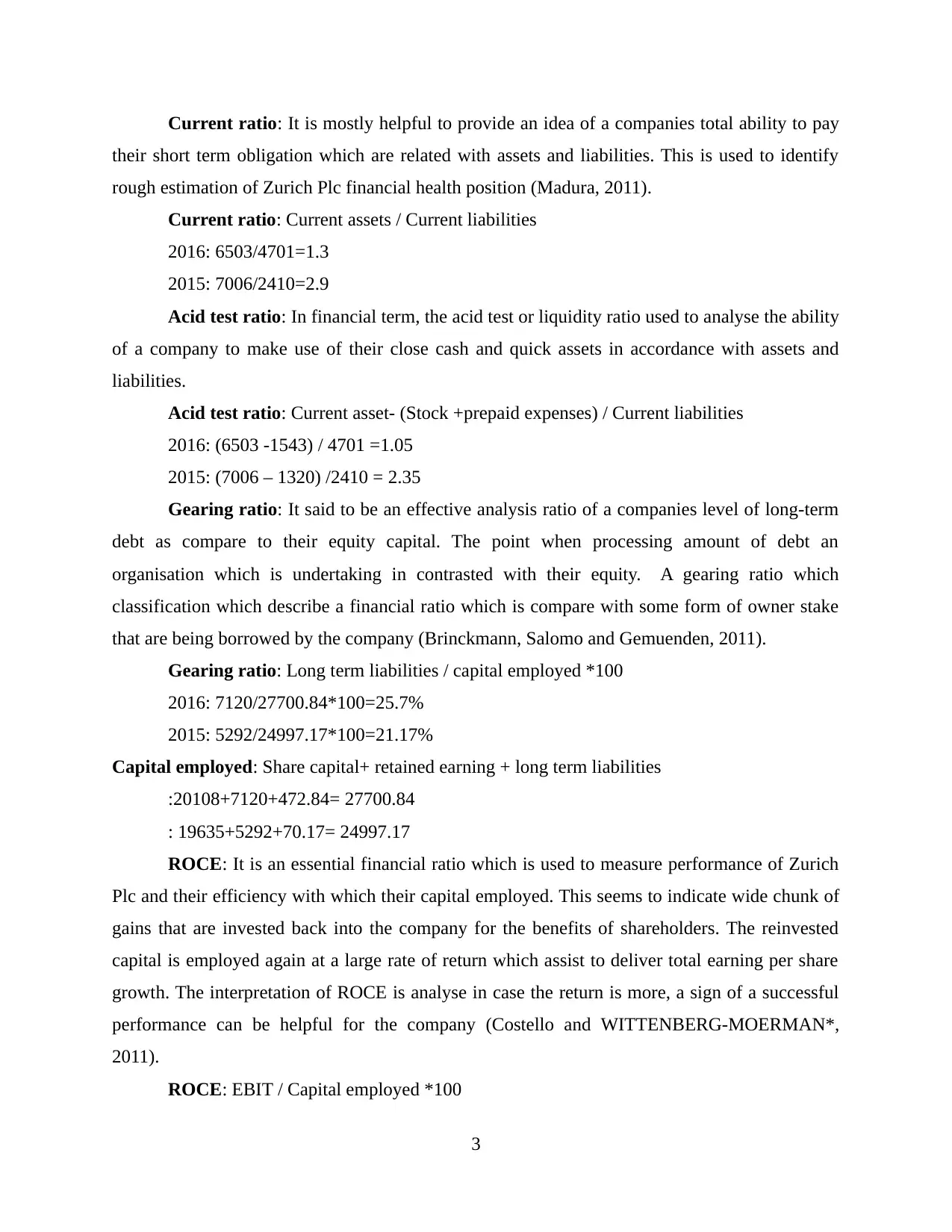
Current ratio: It is mostly helpful to provide an idea of a companies total ability to pay
their short term obligation which are related with assets and liabilities. This is used to identify
rough estimation of Zurich Plc financial health position (Madura, 2011).
Current ratio: Current assets / Current liabilities
2016: 6503/4701=1.3
2015: 7006/2410=2.9
Acid test ratio: In financial term, the acid test or liquidity ratio used to analyse the ability
of a company to make use of their close cash and quick assets in accordance with assets and
liabilities.
Acid test ratio: Current asset- (Stock +prepaid expenses) / Current liabilities
2016: (6503 -1543) / 4701 =1.05
2015: (7006 – 1320) /2410 = 2.35
Gearing ratio: It said to be an effective analysis ratio of a companies level of long-term
debt as compare to their equity capital. The point when processing amount of debt an
organisation which is undertaking in contrasted with their equity. A gearing ratio which
classification which describe a financial ratio which is compare with some form of owner stake
that are being borrowed by the company (Brinckmann, Salomo and Gemuenden, 2011).
Gearing ratio: Long term liabilities / capital employed *100
2016: 7120/27700.84*100=25.7%
2015: 5292/24997.17*100=21.17%
Capital employed: Share capital+ retained earning + long term liabilities
:20108+7120+472.84= 27700.84
: 19635+5292+70.17= 24997.17
ROCE: It is an essential financial ratio which is used to measure performance of Zurich
Plc and their efficiency with which their capital employed. This seems to indicate wide chunk of
gains that are invested back into the company for the benefits of shareholders. The reinvested
capital is employed again at a large rate of return which assist to deliver total earning per share
growth. The interpretation of ROCE is analyse in case the return is more, a sign of a successful
performance can be helpful for the company (Costello and WITTENBERG‐MOERMAN*,
2011).
ROCE: EBIT / Capital employed *100
3
their short term obligation which are related with assets and liabilities. This is used to identify
rough estimation of Zurich Plc financial health position (Madura, 2011).
Current ratio: Current assets / Current liabilities
2016: 6503/4701=1.3
2015: 7006/2410=2.9
Acid test ratio: In financial term, the acid test or liquidity ratio used to analyse the ability
of a company to make use of their close cash and quick assets in accordance with assets and
liabilities.
Acid test ratio: Current asset- (Stock +prepaid expenses) / Current liabilities
2016: (6503 -1543) / 4701 =1.05
2015: (7006 – 1320) /2410 = 2.35
Gearing ratio: It said to be an effective analysis ratio of a companies level of long-term
debt as compare to their equity capital. The point when processing amount of debt an
organisation which is undertaking in contrasted with their equity. A gearing ratio which
classification which describe a financial ratio which is compare with some form of owner stake
that are being borrowed by the company (Brinckmann, Salomo and Gemuenden, 2011).
Gearing ratio: Long term liabilities / capital employed *100
2016: 7120/27700.84*100=25.7%
2015: 5292/24997.17*100=21.17%
Capital employed: Share capital+ retained earning + long term liabilities
:20108+7120+472.84= 27700.84
: 19635+5292+70.17= 24997.17
ROCE: It is an essential financial ratio which is used to measure performance of Zurich
Plc and their efficiency with which their capital employed. This seems to indicate wide chunk of
gains that are invested back into the company for the benefits of shareholders. The reinvested
capital is employed again at a large rate of return which assist to deliver total earning per share
growth. The interpretation of ROCE is analyse in case the return is more, a sign of a successful
performance can be helpful for the company (Costello and WITTENBERG‐MOERMAN*,
2011).
ROCE: EBIT / Capital employed *100
3
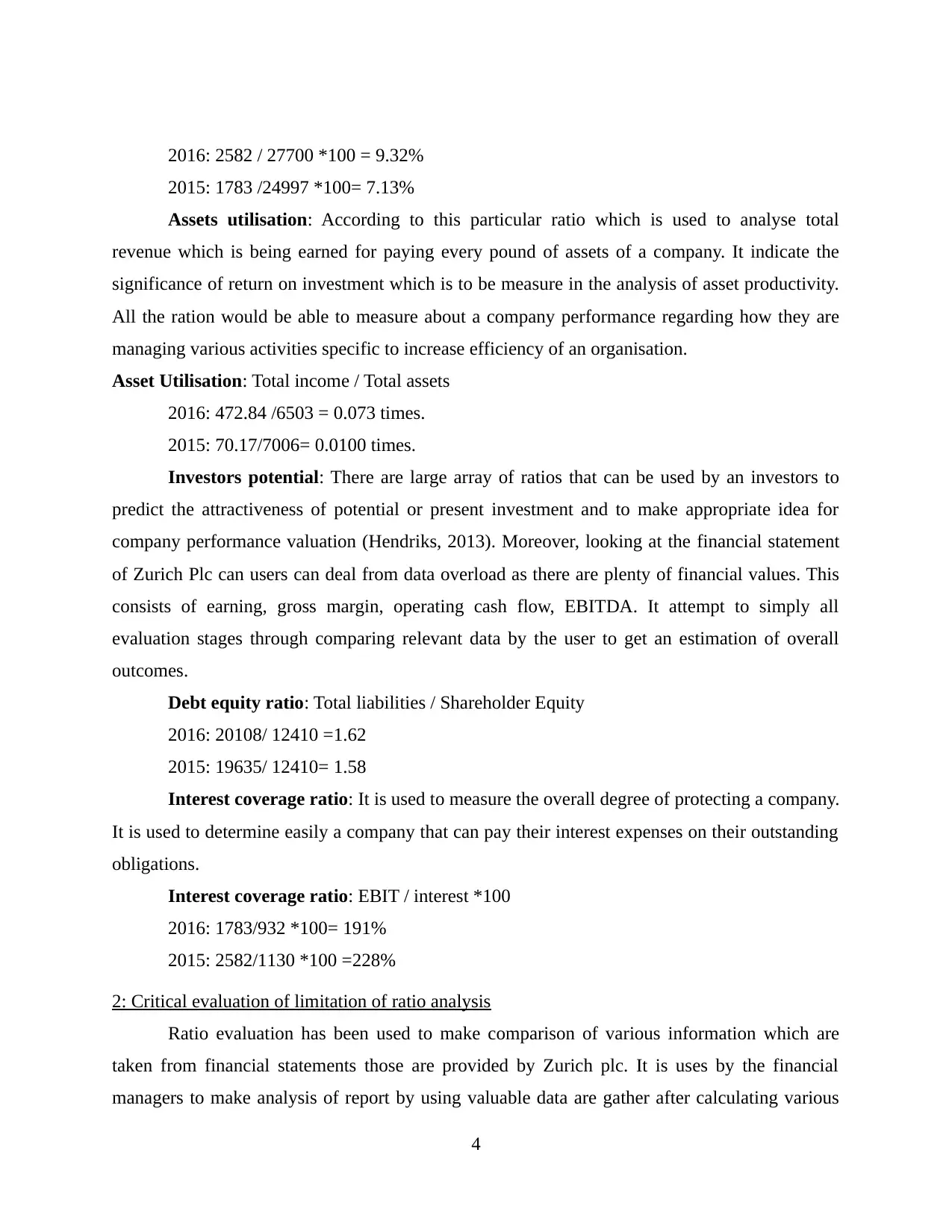
2016: 2582 / 27700 *100 = 9.32%
2015: 1783 /24997 *100= 7.13%
Assets utilisation: According to this particular ratio which is used to analyse total
revenue which is being earned for paying every pound of assets of a company. It indicate the
significance of return on investment which is to be measure in the analysis of asset productivity.
All the ration would be able to measure about a company performance regarding how they are
managing various activities specific to increase efficiency of an organisation.
Asset Utilisation: Total income / Total assets
2016: 472.84 /6503 = 0.073 times.
2015: 70.17/7006= 0.0100 times.
Investors potential: There are large array of ratios that can be used by an investors to
predict the attractiveness of potential or present investment and to make appropriate idea for
company performance valuation (Hendriks, 2013). Moreover, looking at the financial statement
of Zurich Plc can users can deal from data overload as there are plenty of financial values. This
consists of earning, gross margin, operating cash flow, EBITDA. It attempt to simply all
evaluation stages through comparing relevant data by the user to get an estimation of overall
outcomes.
Debt equity ratio: Total liabilities / Shareholder Equity
2016: 20108/ 12410 =1.62
2015: 19635/ 12410= 1.58
Interest coverage ratio: It is used to measure the overall degree of protecting a company.
It is used to determine easily a company that can pay their interest expenses on their outstanding
obligations.
Interest coverage ratio: EBIT / interest *100
2016: 1783/932 *100= 191%
2015: 2582/1130 *100 =228%
2: Critical evaluation of limitation of ratio analysis
Ratio evaluation has been used to make comparison of various information which are
taken from financial statements those are provided by Zurich plc. It is uses by the financial
managers to make analysis of report by using valuable data are gather after calculating various
4
2015: 1783 /24997 *100= 7.13%
Assets utilisation: According to this particular ratio which is used to analyse total
revenue which is being earned for paying every pound of assets of a company. It indicate the
significance of return on investment which is to be measure in the analysis of asset productivity.
All the ration would be able to measure about a company performance regarding how they are
managing various activities specific to increase efficiency of an organisation.
Asset Utilisation: Total income / Total assets
2016: 472.84 /6503 = 0.073 times.
2015: 70.17/7006= 0.0100 times.
Investors potential: There are large array of ratios that can be used by an investors to
predict the attractiveness of potential or present investment and to make appropriate idea for
company performance valuation (Hendriks, 2013). Moreover, looking at the financial statement
of Zurich Plc can users can deal from data overload as there are plenty of financial values. This
consists of earning, gross margin, operating cash flow, EBITDA. It attempt to simply all
evaluation stages through comparing relevant data by the user to get an estimation of overall
outcomes.
Debt equity ratio: Total liabilities / Shareholder Equity
2016: 20108/ 12410 =1.62
2015: 19635/ 12410= 1.58
Interest coverage ratio: It is used to measure the overall degree of protecting a company.
It is used to determine easily a company that can pay their interest expenses on their outstanding
obligations.
Interest coverage ratio: EBIT / interest *100
2016: 1783/932 *100= 191%
2015: 2582/1130 *100 =228%
2: Critical evaluation of limitation of ratio analysis
Ratio evaluation has been used to make comparison of various information which are
taken from financial statements those are provided by Zurich plc. It is uses by the financial
managers to make analysis of report by using valuable data are gather after calculating various
4
⊘ This is a preview!⊘
Do you want full access?
Subscribe today to unlock all pages.

Trusted by 1+ million students worldwide
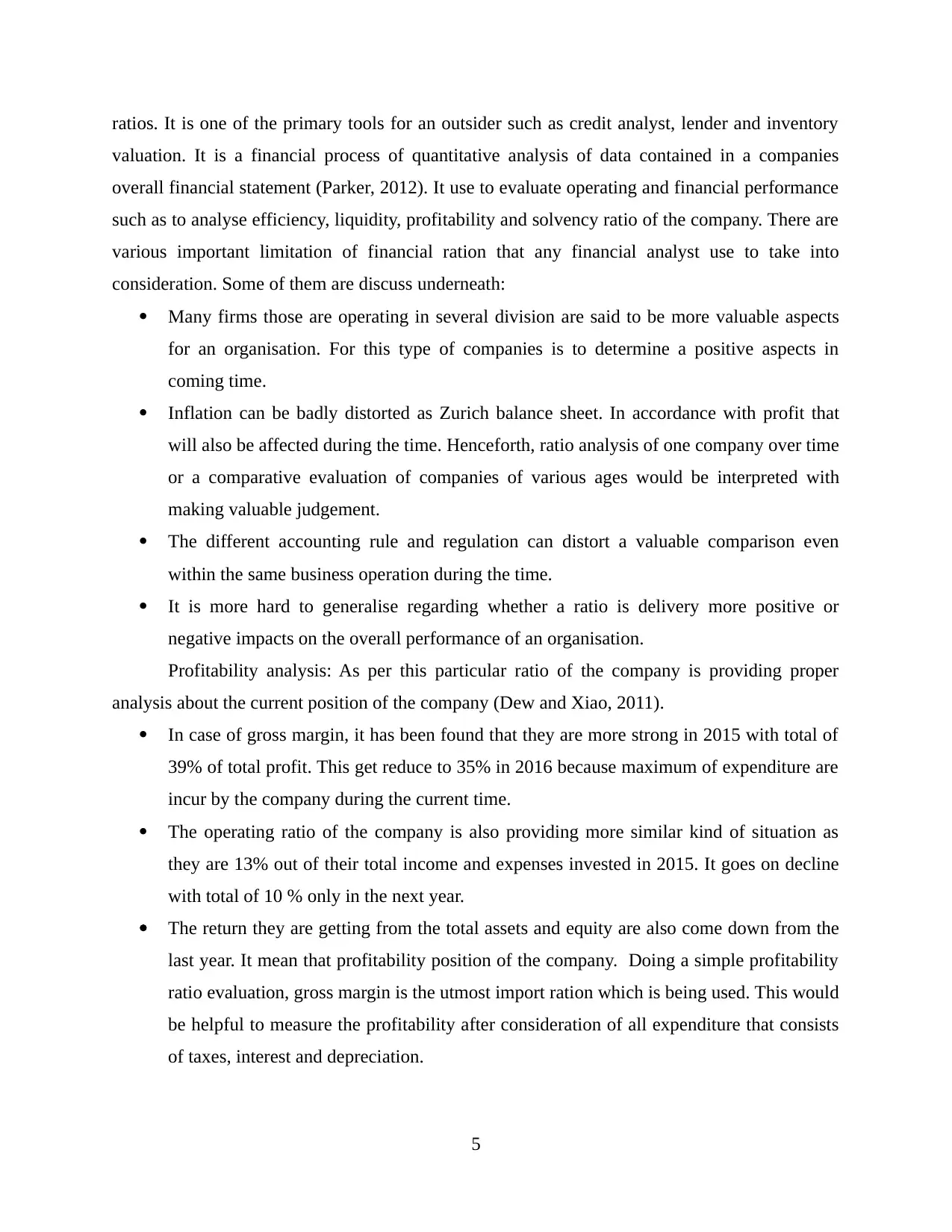
ratios. It is one of the primary tools for an outsider such as credit analyst, lender and inventory
valuation. It is a financial process of quantitative analysis of data contained in a companies
overall financial statement (Parker, 2012). It use to evaluate operating and financial performance
such as to analyse efficiency, liquidity, profitability and solvency ratio of the company. There are
various important limitation of financial ration that any financial analyst use to take into
consideration. Some of them are discuss underneath:
Many firms those are operating in several division are said to be more valuable aspects
for an organisation. For this type of companies is to determine a positive aspects in
coming time.
Inflation can be badly distorted as Zurich balance sheet. In accordance with profit that
will also be affected during the time. Henceforth, ratio analysis of one company over time
or a comparative evaluation of companies of various ages would be interpreted with
making valuable judgement.
The different accounting rule and regulation can distort a valuable comparison even
within the same business operation during the time.
It is more hard to generalise regarding whether a ratio is delivery more positive or
negative impacts on the overall performance of an organisation.
Profitability analysis: As per this particular ratio of the company is providing proper
analysis about the current position of the company (Dew and Xiao, 2011).
In case of gross margin, it has been found that they are more strong in 2015 with total of
39% of total profit. This get reduce to 35% in 2016 because maximum of expenditure are
incur by the company during the current time.
The operating ratio of the company is also providing more similar kind of situation as
they are 13% out of their total income and expenses invested in 2015. It goes on decline
with total of 10 % only in the next year.
The return they are getting from the total assets and equity are also come down from the
last year. It mean that profitability position of the company. Doing a simple profitability
ratio evaluation, gross margin is the utmost import ration which is being used. This would
be helpful to measure the profitability after consideration of all expenditure that consists
of taxes, interest and depreciation.
5
valuation. It is a financial process of quantitative analysis of data contained in a companies
overall financial statement (Parker, 2012). It use to evaluate operating and financial performance
such as to analyse efficiency, liquidity, profitability and solvency ratio of the company. There are
various important limitation of financial ration that any financial analyst use to take into
consideration. Some of them are discuss underneath:
Many firms those are operating in several division are said to be more valuable aspects
for an organisation. For this type of companies is to determine a positive aspects in
coming time.
Inflation can be badly distorted as Zurich balance sheet. In accordance with profit that
will also be affected during the time. Henceforth, ratio analysis of one company over time
or a comparative evaluation of companies of various ages would be interpreted with
making valuable judgement.
The different accounting rule and regulation can distort a valuable comparison even
within the same business operation during the time.
It is more hard to generalise regarding whether a ratio is delivery more positive or
negative impacts on the overall performance of an organisation.
Profitability analysis: As per this particular ratio of the company is providing proper
analysis about the current position of the company (Dew and Xiao, 2011).
In case of gross margin, it has been found that they are more strong in 2015 with total of
39% of total profit. This get reduce to 35% in 2016 because maximum of expenditure are
incur by the company during the current time.
The operating ratio of the company is also providing more similar kind of situation as
they are 13% out of their total income and expenses invested in 2015. It goes on decline
with total of 10 % only in the next year.
The return they are getting from the total assets and equity are also come down from the
last year. It mean that profitability position of the company. Doing a simple profitability
ratio evaluation, gross margin is the utmost import ration which is being used. This would
be helpful to measure the profitability after consideration of all expenditure that consists
of taxes, interest and depreciation.
5
Paraphrase This Document
Need a fresh take? Get an instant paraphrase of this document with our AI Paraphraser
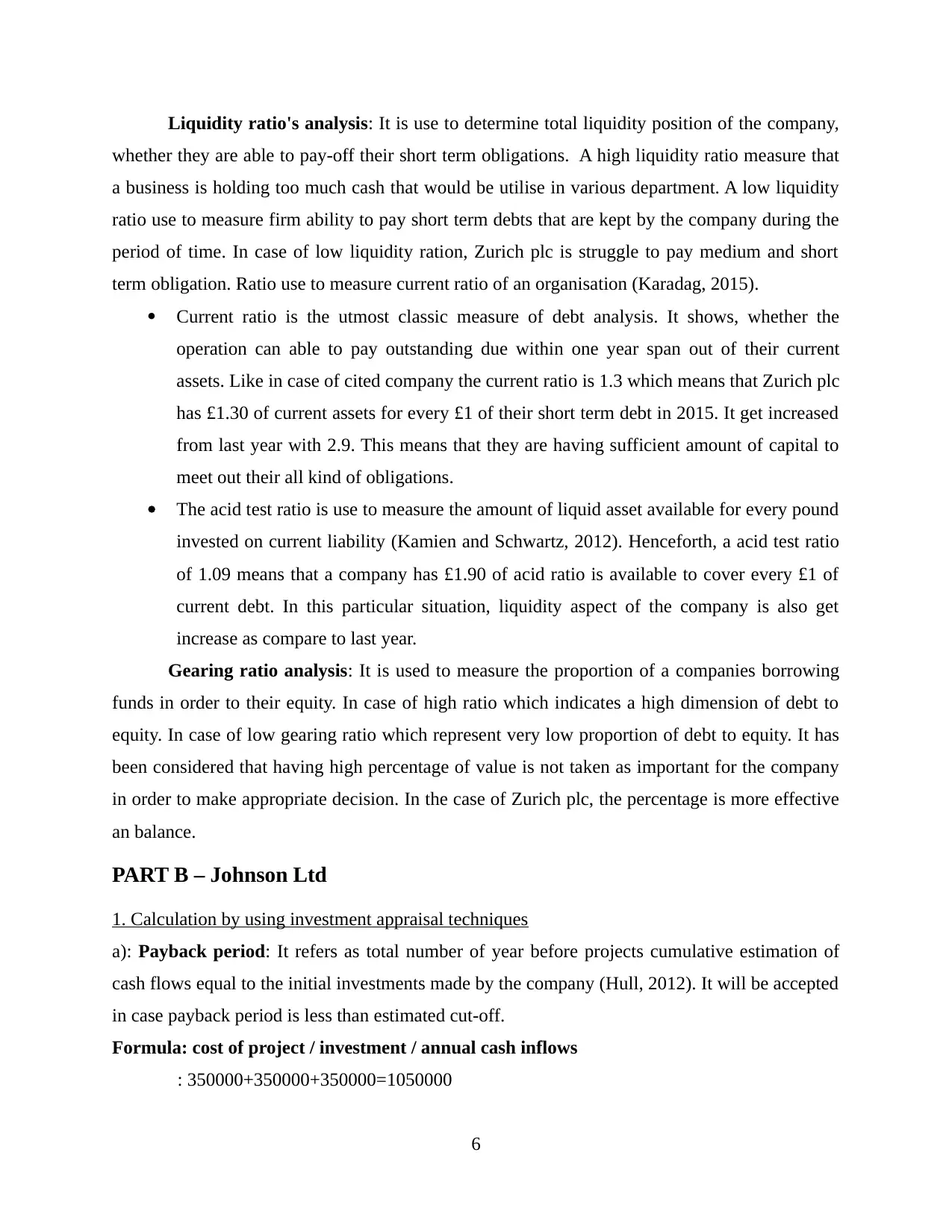
Liquidity ratio's analysis: It is use to determine total liquidity position of the company,
whether they are able to pay-off their short term obligations. A high liquidity ratio measure that
a business is holding too much cash that would be utilise in various department. A low liquidity
ratio use to measure firm ability to pay short term debts that are kept by the company during the
period of time. In case of low liquidity ration, Zurich plc is struggle to pay medium and short
term obligation. Ratio use to measure current ratio of an organisation (Karadag, 2015).
Current ratio is the utmost classic measure of debt analysis. It shows, whether the
operation can able to pay outstanding due within one year span out of their current
assets. Like in case of cited company the current ratio is 1.3 which means that Zurich plc
has £1.30 of current assets for every £1 of their short term debt in 2015. It get increased
from last year with 2.9. This means that they are having sufficient amount of capital to
meet out their all kind of obligations.
The acid test ratio is use to measure the amount of liquid asset available for every pound
invested on current liability (Kamien and Schwartz, 2012). Henceforth, a acid test ratio
of 1.09 means that a company has £1.90 of acid ratio is available to cover every £1 of
current debt. In this particular situation, liquidity aspect of the company is also get
increase as compare to last year.
Gearing ratio analysis: It is used to measure the proportion of a companies borrowing
funds in order to their equity. In case of high ratio which indicates a high dimension of debt to
equity. In case of low gearing ratio which represent very low proportion of debt to equity. It has
been considered that having high percentage of value is not taken as important for the company
in order to make appropriate decision. In the case of Zurich plc, the percentage is more effective
an balance.
PART B – Johnson Ltd
1. Calculation by using investment appraisal techniques
a): Payback period: It refers as total number of year before projects cumulative estimation of
cash flows equal to the initial investments made by the company (Hull, 2012). It will be accepted
in case payback period is less than estimated cut-off.
Formula: cost of project / investment / annual cash inflows
: 350000+350000+350000=1050000
6
whether they are able to pay-off their short term obligations. A high liquidity ratio measure that
a business is holding too much cash that would be utilise in various department. A low liquidity
ratio use to measure firm ability to pay short term debts that are kept by the company during the
period of time. In case of low liquidity ration, Zurich plc is struggle to pay medium and short
term obligation. Ratio use to measure current ratio of an organisation (Karadag, 2015).
Current ratio is the utmost classic measure of debt analysis. It shows, whether the
operation can able to pay outstanding due within one year span out of their current
assets. Like in case of cited company the current ratio is 1.3 which means that Zurich plc
has £1.30 of current assets for every £1 of their short term debt in 2015. It get increased
from last year with 2.9. This means that they are having sufficient amount of capital to
meet out their all kind of obligations.
The acid test ratio is use to measure the amount of liquid asset available for every pound
invested on current liability (Kamien and Schwartz, 2012). Henceforth, a acid test ratio
of 1.09 means that a company has £1.90 of acid ratio is available to cover every £1 of
current debt. In this particular situation, liquidity aspect of the company is also get
increase as compare to last year.
Gearing ratio analysis: It is used to measure the proportion of a companies borrowing
funds in order to their equity. In case of high ratio which indicates a high dimension of debt to
equity. In case of low gearing ratio which represent very low proportion of debt to equity. It has
been considered that having high percentage of value is not taken as important for the company
in order to make appropriate decision. In the case of Zurich plc, the percentage is more effective
an balance.
PART B – Johnson Ltd
1. Calculation by using investment appraisal techniques
a): Payback period: It refers as total number of year before projects cumulative estimation of
cash flows equal to the initial investments made by the company (Hull, 2012). It will be accepted
in case payback period is less than estimated cut-off.
Formula: cost of project / investment / annual cash inflows
: 350000+350000+350000=1050000
6
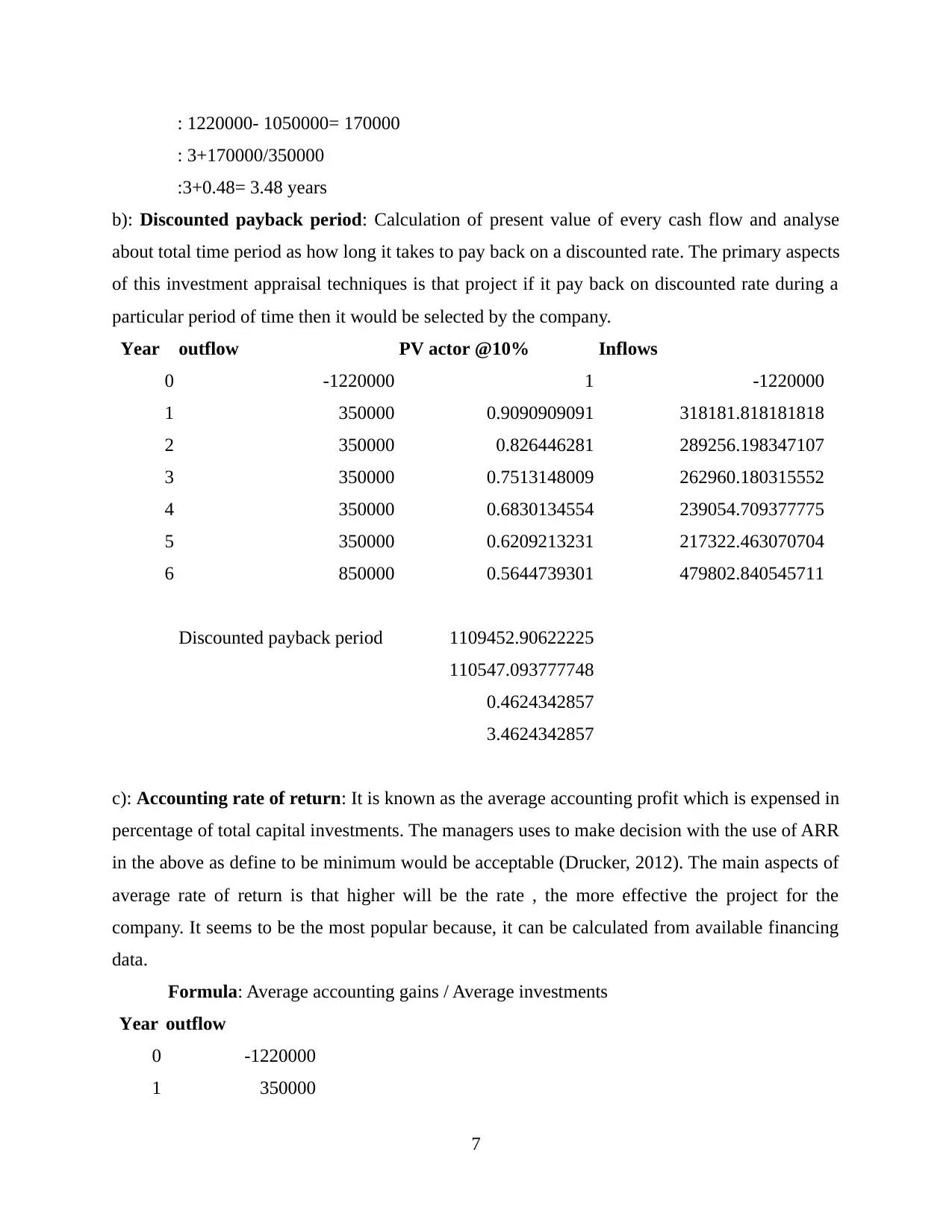
: 1220000- 1050000= 170000
: 3+170000/350000
:3+0.48= 3.48 years
b): Discounted payback period: Calculation of present value of every cash flow and analyse
about total time period as how long it takes to pay back on a discounted rate. The primary aspects
of this investment appraisal techniques is that project if it pay back on discounted rate during a
particular period of time then it would be selected by the company.
Year outflow PV actor @10% Inflows
0 -1220000 1 -1220000
1 350000 0.9090909091 318181.818181818
2 350000 0.826446281 289256.198347107
3 350000 0.7513148009 262960.180315552
4 350000 0.6830134554 239054.709377775
5 350000 0.6209213231 217322.463070704
6 850000 0.5644739301 479802.840545711
Discounted payback period 1109452.90622225
110547.093777748
0.4624342857
3.4624342857
c): Accounting rate of return: It is known as the average accounting profit which is expensed in
percentage of total capital investments. The managers uses to make decision with the use of ARR
in the above as define to be minimum would be acceptable (Drucker, 2012). The main aspects of
average rate of return is that higher will be the rate , the more effective the project for the
company. It seems to be the most popular because, it can be calculated from available financing
data.
Formula: Average accounting gains / Average investments
Year outflow
0 -1220000
1 350000
7
: 3+170000/350000
:3+0.48= 3.48 years
b): Discounted payback period: Calculation of present value of every cash flow and analyse
about total time period as how long it takes to pay back on a discounted rate. The primary aspects
of this investment appraisal techniques is that project if it pay back on discounted rate during a
particular period of time then it would be selected by the company.
Year outflow PV actor @10% Inflows
0 -1220000 1 -1220000
1 350000 0.9090909091 318181.818181818
2 350000 0.826446281 289256.198347107
3 350000 0.7513148009 262960.180315552
4 350000 0.6830134554 239054.709377775
5 350000 0.6209213231 217322.463070704
6 850000 0.5644739301 479802.840545711
Discounted payback period 1109452.90622225
110547.093777748
0.4624342857
3.4624342857
c): Accounting rate of return: It is known as the average accounting profit which is expensed in
percentage of total capital investments. The managers uses to make decision with the use of ARR
in the above as define to be minimum would be acceptable (Drucker, 2012). The main aspects of
average rate of return is that higher will be the rate , the more effective the project for the
company. It seems to be the most popular because, it can be calculated from available financing
data.
Formula: Average accounting gains / Average investments
Year outflow
0 -1220000
1 350000
7
⊘ This is a preview!⊘
Do you want full access?
Subscribe today to unlock all pages.

Trusted by 1+ million students worldwide
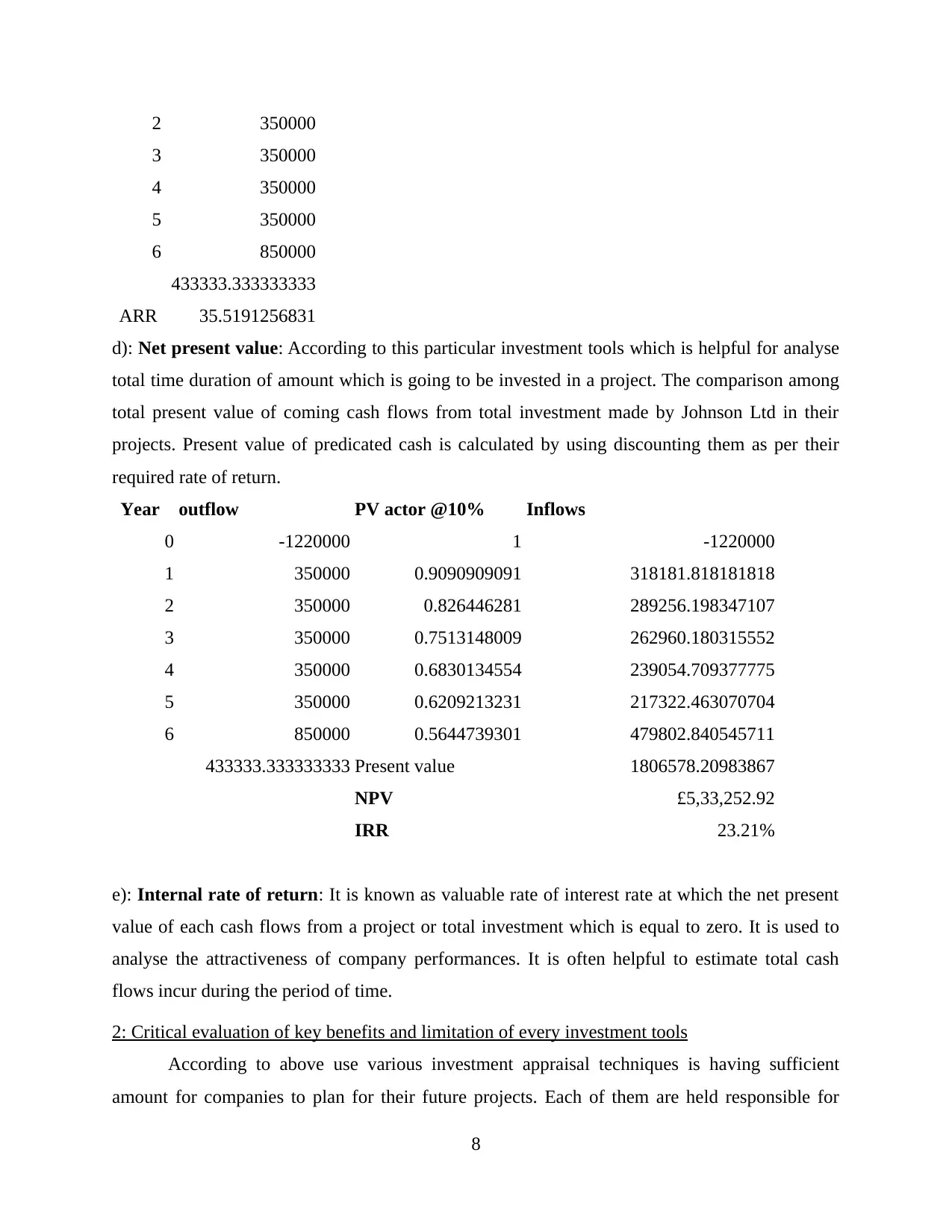
2 350000
3 350000
4 350000
5 350000
6 850000
433333.333333333
ARR 35.5191256831
d): Net present value: According to this particular investment tools which is helpful for analyse
total time duration of amount which is going to be invested in a project. The comparison among
total present value of coming cash flows from total investment made by Johnson Ltd in their
projects. Present value of predicated cash is calculated by using discounting them as per their
required rate of return.
Year outflow PV actor @10% Inflows
0 -1220000 1 -1220000
1 350000 0.9090909091 318181.818181818
2 350000 0.826446281 289256.198347107
3 350000 0.7513148009 262960.180315552
4 350000 0.6830134554 239054.709377775
5 350000 0.6209213231 217322.463070704
6 850000 0.5644739301 479802.840545711
433333.333333333 Present value 1806578.20983867
NPV £5,33,252.92
IRR 23.21%
e): Internal rate of return: It is known as valuable rate of interest rate at which the net present
value of each cash flows from a project or total investment which is equal to zero. It is used to
analyse the attractiveness of company performances. It is often helpful to estimate total cash
flows incur during the period of time.
2: Critical evaluation of key benefits and limitation of every investment tools
According to above use various investment appraisal techniques is having sufficient
amount for companies to plan for their future projects. Each of them are held responsible for
8
3 350000
4 350000
5 350000
6 850000
433333.333333333
ARR 35.5191256831
d): Net present value: According to this particular investment tools which is helpful for analyse
total time duration of amount which is going to be invested in a project. The comparison among
total present value of coming cash flows from total investment made by Johnson Ltd in their
projects. Present value of predicated cash is calculated by using discounting them as per their
required rate of return.
Year outflow PV actor @10% Inflows
0 -1220000 1 -1220000
1 350000 0.9090909091 318181.818181818
2 350000 0.826446281 289256.198347107
3 350000 0.7513148009 262960.180315552
4 350000 0.6830134554 239054.709377775
5 350000 0.6209213231 217322.463070704
6 850000 0.5644739301 479802.840545711
433333.333333333 Present value 1806578.20983867
NPV £5,33,252.92
IRR 23.21%
e): Internal rate of return: It is known as valuable rate of interest rate at which the net present
value of each cash flows from a project or total investment which is equal to zero. It is used to
analyse the attractiveness of company performances. It is often helpful to estimate total cash
flows incur during the period of time.
2: Critical evaluation of key benefits and limitation of every investment tools
According to above use various investment appraisal techniques is having sufficient
amount for companies to plan for their future projects. Each of them are held responsible for
8
Paraphrase This Document
Need a fresh take? Get an instant paraphrase of this document with our AI Paraphraser

their own benefits. Such as accounting rate of return is a practical and helpful ratio for managers
to make analysis of best alternative projects (Lawrence, 2013).
Advantage of ARR:
It is often argue that after any decision is made, the company can use accounting rate of
return as important techniques to follow up their profitability and cost saving to attain set
objective on the basis of capital investments. It can assist Johnson Plc is to analysis ratio that can
use to control and manage more effectively their ongoing projects.
Limitation:
As per this concept of accounting rate of return which is related with practical and useful
for the company. It main limitation of this tools is that it does not consider time value of money.
It means that it fails to consider return on capital invested through normal manner.
Benefits of Payback period:
It is said to be more simplest ratio which is used to analyse best alternative of investment
projects. By this particular investment appraisal tools total time of investment recovery can be
easily be determine by the company. The term payback period is advert for capital budgeting
project to recover their capital investment made in the beginning. The core idea of payback
method is that to determine risk associated with projects and consider best in case the recover is
made before the maturity period of time.
Limitation:
It has been found that there are various drawbacks of using this particular investment
techniques. It is not useful for very long time for the company. It does not consider any
advantage those are occurs after the payback period as well as not able to measure profitability
position in effective manner. The other important aspect of this is that because of time value of
money into account they have to face various implications.
Advantage of NPV: This seems to be use for the purpose of analysing worth creation for
the company. It is a standard techniques which is mainly applicable in using time value of money
for long term project. It is widely helpful for capital budgeting and recognise throughout the field
of investment those are made during the period of time. In recent time, this method is the mostly
accepted and implied as mathematical tools for analysing capital investment projects. The main
advantage of this particular method is to generate valuable outcomes in more sufficiently
dependable and positive to act directly to measure contribution to their stakeholders wealth.
9
to make analysis of best alternative projects (Lawrence, 2013).
Advantage of ARR:
It is often argue that after any decision is made, the company can use accounting rate of
return as important techniques to follow up their profitability and cost saving to attain set
objective on the basis of capital investments. It can assist Johnson Plc is to analysis ratio that can
use to control and manage more effectively their ongoing projects.
Limitation:
As per this concept of accounting rate of return which is related with practical and useful
for the company. It main limitation of this tools is that it does not consider time value of money.
It means that it fails to consider return on capital invested through normal manner.
Benefits of Payback period:
It is said to be more simplest ratio which is used to analyse best alternative of investment
projects. By this particular investment appraisal tools total time of investment recovery can be
easily be determine by the company. The term payback period is advert for capital budgeting
project to recover their capital investment made in the beginning. The core idea of payback
method is that to determine risk associated with projects and consider best in case the recover is
made before the maturity period of time.
Limitation:
It has been found that there are various drawbacks of using this particular investment
techniques. It is not useful for very long time for the company. It does not consider any
advantage those are occurs after the payback period as well as not able to measure profitability
position in effective manner. The other important aspect of this is that because of time value of
money into account they have to face various implications.
Advantage of NPV: This seems to be use for the purpose of analysing worth creation for
the company. It is a standard techniques which is mainly applicable in using time value of money
for long term project. It is widely helpful for capital budgeting and recognise throughout the field
of investment those are made during the period of time. In recent time, this method is the mostly
accepted and implied as mathematical tools for analysing capital investment projects. The main
advantage of this particular method is to generate valuable outcomes in more sufficiently
dependable and positive to act directly to measure contribution to their stakeholders wealth.
9
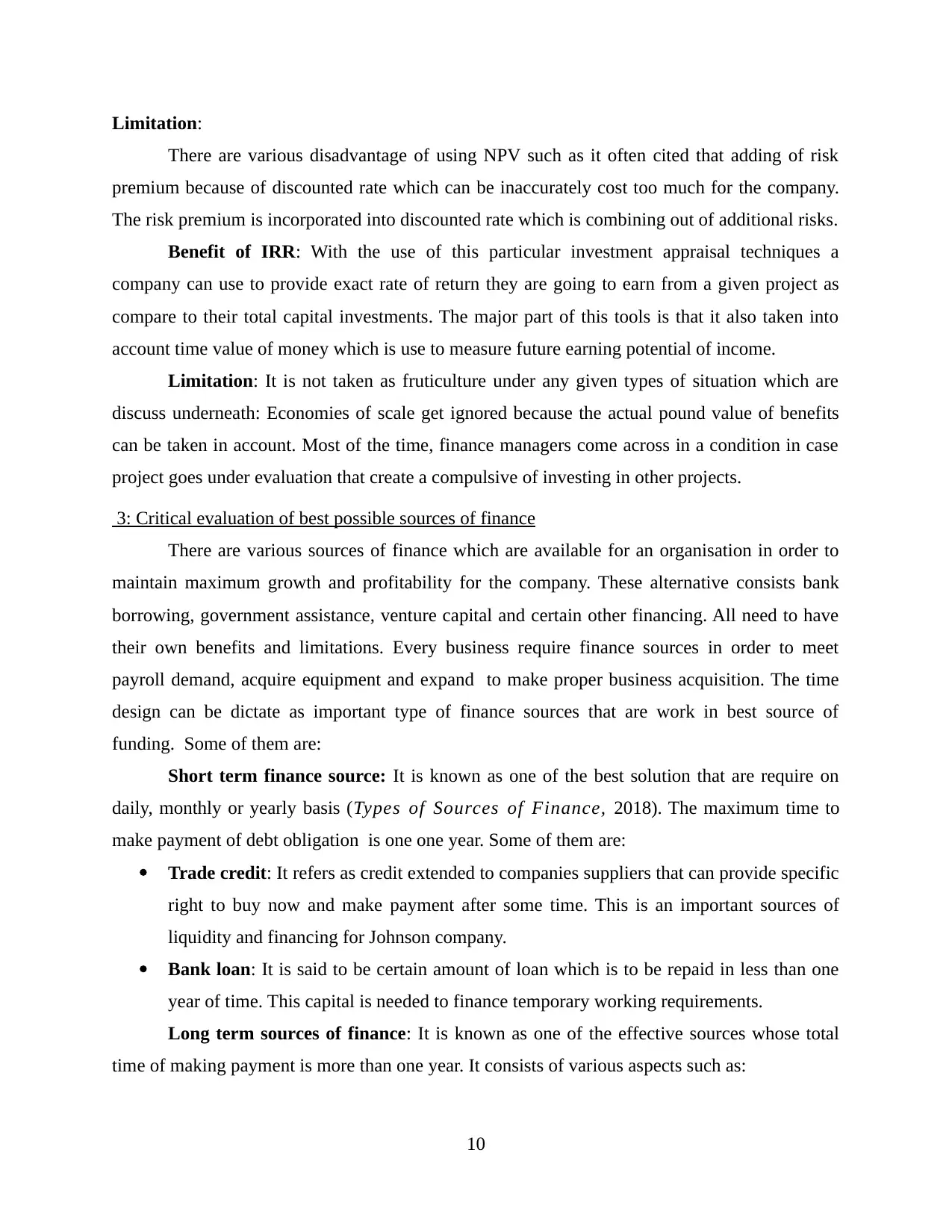
Limitation:
There are various disadvantage of using NPV such as it often cited that adding of risk
premium because of discounted rate which can be inaccurately cost too much for the company.
The risk premium is incorporated into discounted rate which is combining out of additional risks.
Benefit of IRR: With the use of this particular investment appraisal techniques a
company can use to provide exact rate of return they are going to earn from a given project as
compare to their total capital investments. The major part of this tools is that it also taken into
account time value of money which is use to measure future earning potential of income.
Limitation: It is not taken as fruticulture under any given types of situation which are
discuss underneath: Economies of scale get ignored because the actual pound value of benefits
can be taken in account. Most of the time, finance managers come across in a condition in case
project goes under evaluation that create a compulsive of investing in other projects.
3: Critical evaluation of best possible sources of finance
There are various sources of finance which are available for an organisation in order to
maintain maximum growth and profitability for the company. These alternative consists bank
borrowing, government assistance, venture capital and certain other financing. All need to have
their own benefits and limitations. Every business require finance sources in order to meet
payroll demand, acquire equipment and expand to make proper business acquisition. The time
design can be dictate as important type of finance sources that are work in best source of
funding. Some of them are:
Short term finance source: It is known as one of the best solution that are require on
daily, monthly or yearly basis (Types of Sources of Finance, 2018). The maximum time to
make payment of debt obligation is one one year. Some of them are:
Trade credit: It refers as credit extended to companies suppliers that can provide specific
right to buy now and make payment after some time. This is an important sources of
liquidity and financing for Johnson company.
Bank loan: It is said to be certain amount of loan which is to be repaid in less than one
year of time. This capital is needed to finance temporary working requirements.
Long term sources of finance: It is known as one of the effective sources whose total
time of making payment is more than one year. It consists of various aspects such as:
10
There are various disadvantage of using NPV such as it often cited that adding of risk
premium because of discounted rate which can be inaccurately cost too much for the company.
The risk premium is incorporated into discounted rate which is combining out of additional risks.
Benefit of IRR: With the use of this particular investment appraisal techniques a
company can use to provide exact rate of return they are going to earn from a given project as
compare to their total capital investments. The major part of this tools is that it also taken into
account time value of money which is use to measure future earning potential of income.
Limitation: It is not taken as fruticulture under any given types of situation which are
discuss underneath: Economies of scale get ignored because the actual pound value of benefits
can be taken in account. Most of the time, finance managers come across in a condition in case
project goes under evaluation that create a compulsive of investing in other projects.
3: Critical evaluation of best possible sources of finance
There are various sources of finance which are available for an organisation in order to
maintain maximum growth and profitability for the company. These alternative consists bank
borrowing, government assistance, venture capital and certain other financing. All need to have
their own benefits and limitations. Every business require finance sources in order to meet
payroll demand, acquire equipment and expand to make proper business acquisition. The time
design can be dictate as important type of finance sources that are work in best source of
funding. Some of them are:
Short term finance source: It is known as one of the best solution that are require on
daily, monthly or yearly basis (Types of Sources of Finance, 2018). The maximum time to
make payment of debt obligation is one one year. Some of them are:
Trade credit: It refers as credit extended to companies suppliers that can provide specific
right to buy now and make payment after some time. This is an important sources of
liquidity and financing for Johnson company.
Bank loan: It is said to be certain amount of loan which is to be repaid in less than one
year of time. This capital is needed to finance temporary working requirements.
Long term sources of finance: It is known as one of the effective sources whose total
time of making payment is more than one year. It consists of various aspects such as:
10
⊘ This is a preview!⊘
Do you want full access?
Subscribe today to unlock all pages.

Trusted by 1+ million students worldwide
1 out of 14
Related Documents
Your All-in-One AI-Powered Toolkit for Academic Success.
+13062052269
info@desklib.com
Available 24*7 on WhatsApp / Email
![[object Object]](/_next/static/media/star-bottom.7253800d.svg)
Unlock your academic potential
Copyright © 2020–2025 A2Z Services. All Rights Reserved. Developed and managed by ZUCOL.




